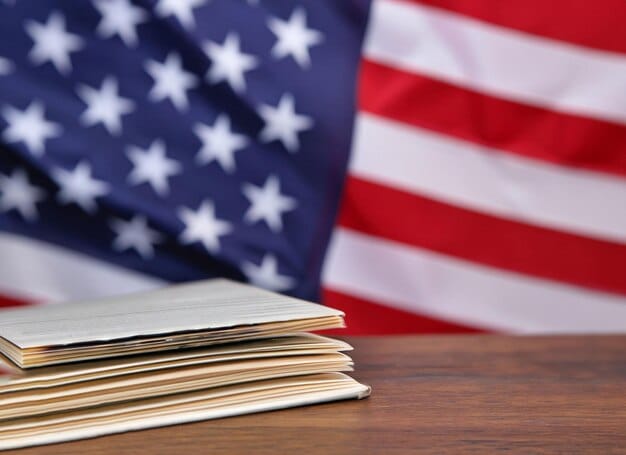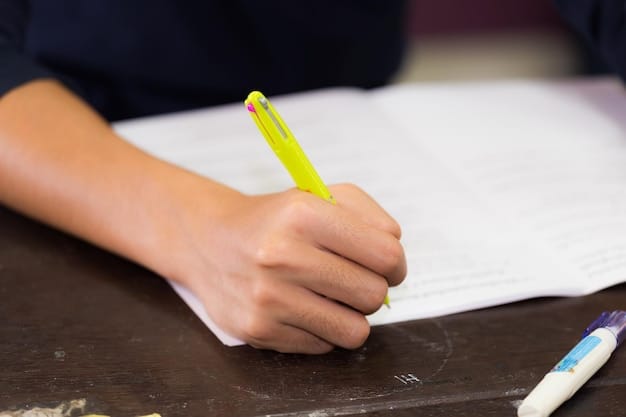Understanding the New US Education Guidelines for Loan Forgiveness in 2025

Anúncios
Understanding the New US Department of Education Guidelines for Student Loan Forgiveness in 2025 involves navigating updated eligibility criteria, application processes, and potential changes to income-driven repayment plans, aiming to provide more accessible and equitable debt relief for eligible borrowers.
Are you one of the millions of Americans burdened by student loan debt? Understanding the New US Department of Education Guidelines for Student Loan Forgiveness in 2025 is crucial, as they could significantly impact your eligibility and the amount of debt you can have forgiven. Let’s dive in!
Anúncios
What’s New in the 2025 Student Loan Forgiveness Guidelines?
The US Department of Education is constantly refining its student loan forgiveness programs to better serve borrowers. The 2025 guidelines bring some notable changes that aim to streamline the process and expand eligibility. Let’s explore the key updates.
Anúncios
The 2025 guidelines aren’t just a minor tweak; they represent a significant shift in how the government approaches student loan forgiveness. Understanding these changes is essential for anyone currently repaying student loans or considering further education.
Expanded Eligibility Criteria
One of the most significant changes is the expansion of eligibility criteria for certain forgiveness programs. The new guidelines aim to include more borrowers who were previously excluded due to technicalities or stringent requirements.
- Income-Driven Repayment (IDR) Plans: The income thresholds have been adjusted, potentially allowing more borrowers with lower incomes to qualify.
- Public Service Loan Forgiveness (PSLF): Certain types of public service employment that were previously ineligible may now qualify.
- Borrower Defense to Repayment: The process for claiming borrower defense has been streamlined, making it easier for borrowers defrauded by their schools to seek relief.
These expanded criteria represent a concerted effort to make loan forgiveness more accessible to those who need it most. By broadening the eligibility net, the Department of Education hopes to reduce the burden of student debt for a wider range of Americans.

Key Provisions of the Updated Guidelines
Beyond eligibility, the updated guidelines also include key provisions that affect the amount of forgiveness borrowers can receive and how the forgiveness process works. Let’s take a closer look at these critical provisions.
These provisions are designed to make the loan forgiveness process fairer and more transparent, ensuring that borrowers are fully informed about their rights and options.
Changes to Income-Driven Repayment (IDR) Plans
Income-driven repayment plans are a popular option for borrowers struggling to afford their monthly payments. The 2025 guidelines introduce some important changes to these plans.
- Lower Monthly Payments: The percentage of discretionary income used to calculate monthly payments may be reduced, resulting in lower payments.
- Faster Forgiveness Timelines: The timeline for achieving forgiveness under IDR plans may be shortened for certain borrowers.
- Increased Protections: Borrowers may receive increased protections against accruing interest and penalties while enrolled in IDR plans.
Simplifying the Application Process
One of the biggest pain points for borrowers seeking loan forgiveness is the complex and often confusing application process. The 2025 guidelines aim to simplify this process significantly.
The Department of Education is working to create a more user-friendly online application portal, reduce paperwork, and provide clearer instructions and guidance to borrowers. This streamlined process should make it easier for eligible borrowers to apply for and receive loan forgiveness.
The updated guidelines for student loan forgiveness in 2025 encompass key provisions that aim to provide greater support and clarity for borrowers navigating income-driven repayment options and application processes.
Who Benefits Most From These Changes?
While the updated guidelines aim to benefit a wide range of borrowers, some groups stand to gain more than others. Understanding who benefits most can help you assess whether these changes apply to your specific situation.
These changes are particularly beneficial for low-income borrowers, public service employees, and those who have been defrauded by their schools.
Low-Income Borrowers
The expanded eligibility criteria and changes to IDR plans are particularly beneficial for low-income borrowers who are struggling to afford their monthly payments. Lower monthly payments and faster forgiveness timelines can provide significant financial relief.
Public Service Employees
The PSLF program offers loan forgiveness to borrowers who work in public service jobs. The updated guidelines expand the types of employment that qualify for PSLF, potentially making it easier for public service employees to have their loans forgiven.
Borrowers Defrauded by Their Schools
The streamlined borrower defense to repayment process makes it easier for borrowers who have been defrauded by their schools to seek loan forgiveness. This can provide much-needed relief to those who have been victims of predatory lending practices.

How to Prepare for the 2025 Guidelines
To take full advantage of the 2025 student loan forgiveness guidelines, it’s important to prepare in advance. Here are some steps you can take to ensure you’re ready to apply when the time comes.
By taking these steps, you can increase your chances of successfully applying for and receiving loan forgiveness.
Review Your Eligibility
The first step is to review your eligibility for the various forgiveness programs. Check the Department of Education’s website for updated eligibility criteria and make sure you meet the requirements.
Gather Your Documentation
Gather all the necessary documentation to support your application, such as income statements, employment verification, and school transcripts. Having these documents ready will speed up the application process.
Monitor for Updates
Stay informed about the latest updates to the guidelines by monitoring the Department of Education’s website and following reputable financial news outlets. This will help you stay ahead of any changes or deadlines.
Common Misconceptions About Loan Forgiveness
There are many misconceptions about student loan forgiveness programs, which can lead to confusion and missed opportunities. Let’s debunk some of the most common myths.
By understanding the facts about loan forgiveness, you can make informed decisions about your student loans and avoid falling prey to scams or misinformation.
- Myth: Loan forgiveness is automatic. Fact: You must apply for loan forgiveness and meet specific eligibility criteria.
- Myth: All student loans are eligible for forgiveness. Fact: Only certain types of federal student loans are eligible for forgiveness. Private student loans are typically not eligible.
- Myth: Loan forgiveness is taxable. Fact: In many cases, loan forgiveness is not taxable under current law, but this can change, so it’s important to stay informed.
Navigating the Application Process in 2025
The application process for student loan forgiveness can be daunting, but with careful preparation and attention to detail, you can navigate it successfully. Here’s a step-by-step guide to help you through the process.
By following these steps, you can increase your chances of submitting a complete and accurate application and receiving the loan forgiveness you’re entitled to.
- Step 1: Determine Your Eligibility: Review the eligibility criteria for the various forgiveness programs and determine which one you qualify for.
- Step 2: Gather Your Documents: Collect all the necessary documentation, such as income statements, employment verification, and school transcripts.
- Step 3: Complete the Application: Fill out the application form carefully and accurately, providing all the required information.
- Step 4: Submit Your Application: Submit your application through the Department of Education’s online portal or by mail, following the instructions provided.
- Step 5: Track Your Application: Monitor the status of your application and respond promptly to any requests for additional information.
Staying abreast of the application process developments surrounding student loans and related relief prospects can help individuals strategically navigate financial requirements in 2025.
| Key Point | Brief Description |
|---|---|
| 🔑 Eligibility Expansion | More borrowers may qualify for forgiveness programs. |
| 💰 IDR Plan Changes | Lower payments & faster forgiveness timelines. |
| 📝 Simplified Application | Streamlined process for easier application. |
| 🛡️ Borrower Protections | Increased protection against accruing penalties. |
Frequently Asked Questions (FAQ)
▼
Generally, federal student loans, such as Direct Loans and FFEL loans, are eligible. Private loans typically are not. Specific eligibility can vary by forgiveness program.
▼
You’ll need to complete an application through the US Department of Education’s website. Make sure to gather all necessary documentation beforehand for a smooth process.
▼
Under current law, loan forgiveness is often not considered taxable income. However, this can change, so it’s essential to stay updated on the latest tax regulations.
▼
IDR plans base your monthly loan payments on your income and family size. After a set number of years, typically 20-25, the remaining balance is forgiven.
▼
PSLF forgives the remaining balance on your Direct Loans after you’ve worked full-time for a qualifying employer for 10 years and made 120 qualifying payments.
Conclusion
Understanding the New US Department of Education Guidelines for Student Loan Forgiveness in 2025 is crucial for borrowers seeking financial relief. By staying informed, preparing your application carefully, and avoiding common misconceptions, you can navigate the process successfully and take advantage of the opportunities available to reduce or eliminate your student loan debt.